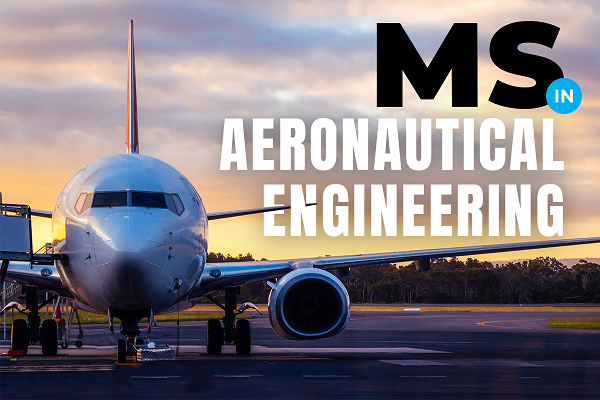Table of Contents
Pursuing an MS in Aeronautical Engineering means mastering the art of designing and building aircrafts, satellites, and missiles. You will have to learn how the atmosphere aids flight, how to develop machines and make flying more efficient.
The topmost universities in the world, like MIT and Stanford, offer some of the best Aeronautical Engineering courses in the world, and we’ll cover them further ahead in this blog.
We will also look at the cost of studying Aeronautical Engineering and look at the application requirements for the course.
But before we get started, let us tell you how it ends. When you graduate after pursuing an MS in Aeronautical Engineering, you can get any job you want – Aeronautical designer, Consultant, or Researcher.
Hell, you could be working with some of the best organizations in the world, like SpaceX, Boeing, or even NASA!
What is Aeronautical Engineering?
In simple terms, Aeronautical engineering is the field of studying different types of aircraft and understanding their working mechanism.
Aeronautical engineers specialize in the design, construction, and maintenance of aircraft, spacecraft, satellites, missiles, and weapons systems.
One part of the job involves researching the latest technologies, another part deals with maintaining the existing systems and keeping them in shape.
To be able to do all this flawlessly, you will need to study Aeronautical Engineering thoroughly and graduate from one of the top Aeronautical Engineering schools in the world.
Best Aeronautical Engineering schools in the world
Do you already have a bachelors in Aeronautical Engineering or have majored in it during your undergraduate course? This will make it much easier for you to get into an MS in Aeronautical Engineering program.
If not that, a degree in a related field or relative work experience will also give you a pathway into getting an admit.
To get started, you can check out the top Aeronautical Engineering schools in the world-
- Massachusetts Institute of Technology (MIT), USA
- Stanford University, USA
- University of Cambridge, UK
- Harvard University, USA
- Delft University of Technology, the Netherlands
- University of California, Berkeley, USA
- Imperial College London, UK
- University of Oxford, UK
- Politecnico di Milano, Italy
- University of Michigan – Ann Arbor
You should know that there are 2 intakes every year.
The Fall intake happens in August, and the Spring intake takes place in January.
I suggest you visit the course websites of the universities you are interested in, take a look at their individual deadlines (usually, it’s December for Fall courses and May for Spring programs), and start your application process accordingly.
Aeronautical Engineering subjects
To be a successful Aeronautical engineer, you need to have mastered two domains – machinery and air dynamics.
To that end, the subjects you’ll study while pursuing an MS in Aeronautical Engineering will include-
- Mathematics
- Engineering Physics
- Engineering Graphics
- Flight Dynamics
- Fluid Mechanics and Machinery Laboratory
- Control Engineering
- Vibrations and Elements of Aeroelasticity
- Composite Materials and Structures
- Aero Engineering Thermodynamics
- Aero Engine and Airframe
- Computer-Aided Simulation
- Avionics
- Propulsion
- Mechanics of Machines
- Aerodynamics, and more
As you can see, these subjects majorly cover designing machines, understanding how they’ll function in flight, and formulating methods to control their movement.
You will learn these subjects in different levels of detail each semester, picking up the necessary skills one by one.
Aeronautical Engineering fees

Now, let’s consider how much these course credits might cost.
The amount will change depending on which country, university, and subjects you choose to study.
But for the universities listed above, the Aeronautical Engineering fee is-
25,000 USD to about 55,000 USD
And that’s just the tuition fees.
Your additional expenses will include the cost of living, food, transport, entertainment, and a few other daily spendings. This amount will vary depending on the country and the university you pick. If you choose to live in the city, your living expenses will go up.
Similarly, studying in countries like the US, UK, and Singapore will cost you a lot more than studying in Canada, Germany, or the Netherlands.
To offset your fee and living costs, you can always work part-time, get a teaching assistantship, or apply for a scholarship. They will help you a long way when it comes to funding your education in Data Science.
Application requirements
After you’ve shortlisted the universities you want to apply to, you will have to go through their websites and find out the admission requirements.
However, a few requirements are common across all universities. You will need to provide –
Proof of language proficiency (TOEFL, IELTS, or PTE test scores)
Standard test scores (GRE or GMAT)
I suggest you start preparing these documents 6 months before you have to apply.
After you submit your application, it is time to wait.
If shortlisted, you will receive a letter of acceptance, which you can then use to apply for a student visa (and even a scholarship)!
Is Aeronautical Engineering for me?

Doing an MS in Aeronautical Engineering requires what any other subject would – a great zeal to learn as much as you can so you can put your knowledge to good use.
If you are passionate about understanding how flying machines work, love pulling apart machines and rebuilding them, and someday want to design your own aircraft, then this field is for you.
And if you focus on your mathematics, thermodynamics, and physics chops, it won’t be very difficult to get there.
Maybe someday, you might even learn to fly your own model of Boeing 737 Max!
As far as studying abroad goes, building a strong profile before you apply will take you a long way.
If you’re still unsure, though, and need some more information, feel free to drop a comment or reach out to us!
We’d be very happy to help.






